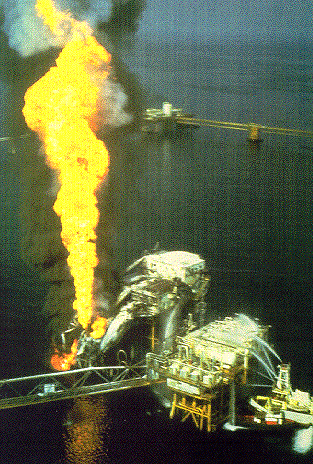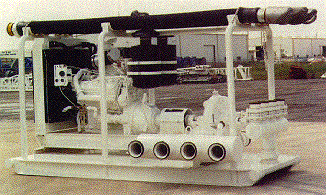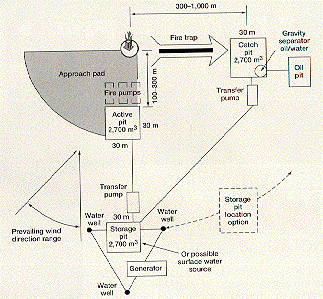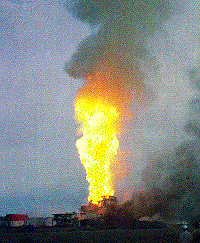![]()
 Part 9-Firefighting. The mechanics of oil/gas fires, meltdown and secondary
damage, water/chemical/explosive extinguishing methods and considerations for voluntary
ignition
Part 9-Firefighting. The mechanics of oil/gas fires, meltdown and secondary
damage, water/chemical/explosive extinguishing methods and considerations for voluntary
ignition
Coots Matthews, Consultant, Boots & Coots L.P.,
L. Flak, former Wright, Boots & Coots, employee.
This article deals with the highly visible and potentially dangerous operations of extinguishing and capping burning blowouts. To understand the nature of oil and gas fires in blowout conditions, basic mechanics and terms are explained, and important features of meltdown and radiant heat exposure limits are discussed. Methods of extinguishing fire with water, chemicals and explosives are described, and examples of cap ping a well while it is burning are given. Finally, reasons for voluntarily igniting a blowout in high risk wells are presented.
Surprisingly few surface blowouts ever ignite. Except in Kuwait, in 1991, less than 10 blow outs per year ever catch on fire, world wide. Typically, large formation water flows lifted by the hydrocarbon flow make ignition difficult if not impossible. Water cones into the blowout zone, drawn in by low flowing bottomhole pressure; or adjacent wet zones are exposed to the flow path.
Highly flammable blowouts may never ignite if no ignition source is present and flow is quickly dispersed. Thus, knowledgeable and experienced blowout specialists always restrict blowout access and carefully inspect the area around blowouts for ignition sources, particularly areas within an explosive vapor cloud. Failure to do this on a recent inland barge blowout in South Louisiana resulted in two deaths and other severe injuries.(1) "Victory awaits those who have everything in order-people call that luck. Defeat awaits those who don't- this they call bad luck." Roald Amundsen (leader of the first expedition to reach the South Pole)(2)
 Knowledge that hydrocarbons are highly flammable is common to our industry.
Less well known are the explosive characteristics of hydrocarbon vapor-air mixtures and
the dramatic impact of ignition of these mixtures on surrounding structures and personnel.
To understand this risk, some ignition terms must be understood.
Knowledge that hydrocarbons are highly flammable is common to our industry.
Less well known are the explosive characteristics of hydrocarbon vapor-air mixtures and
the dramatic impact of ignition of these mixtures on surrounding structures and personnel.
To understand this risk, some ignition terms must be understood.
Flashpoint is the lowest temperature at which a material gives off enough flammable vapor to produce a momentary flash when exposed to a small flame. The flash point of gasoline is -43 deg. C (-45 deg. F), which is the reason it is considered highly flammable.
Spontaneous ignition temperature is the minimum temperature at which a material spontaneously ignites. Methane has a relatively high spontaneous ignition temperature of 537 deg. C (999 deg. F). This makes re-ignition of a methane fuel fire after extinguishment difficult. In practice, low-flash-point, low-spontaneous-ignition-temperature gas condensate blowouts present the greatest blowout ignition hazard.
Explosive limit of differing blowout flows varies with chemical composition. There is a minimum ratio of hydrocarbon vapor to air, below which ignition will not occur. Alternately, there is also a maximum ratio of hydrocarbon vapor to air, at which ignition will not occur. These limits are termed the lower and upper explosive limits. For gasoline vapor, the explosive range is from 1.3 to 6.0% vapor to air. For methane, this range is 5 to 15%. "Crude oil is a highly volatile, explosive cocktail which is lighter than water and burns twice as hot as coal. " (3) Vapor cloud explosion is possible through the following sequence:
Research has shown that speed of the flame front movement is directly proportional to the amount of blast over-pressure. High flame front speeds and resulting high blast over pressures are seen in situations where there is a significant amount of confinement and congestion that limits flame front expansion and increases flame turbulence.
Most vapor cloud explosions are deflagrations, not detonations. Flame speed of a deflagration is subsonic, with flame speed increasing in restricted areas and decreasing in open areas. Significantly, a detonation is supersonic, and will proceed through almost all of the available flammable vapor at the detonation reaction rate. This creates far more severe peak over-pressures and much higher amounts of blast energy (4).
Offshore rigs, production platforms and inland barges are at greatest risk. Hard-welded quarters and other enclosed areas are at particular risk as it is possible to get detonation in these confined areas.
The pressure-feed fire of a blowout will totally destroy the surrounding steel structure in minutes. Derricks have fallen-in less than 30 minutes after blowout ignition. The core temperature of a low-GOR 28 deg. F API crude oil blowout in Kuwait was measured at 1,677 deg. C (3,051 deg. F). And a radiant heat temperature of 510 deg. C (950 deg. F) was measured at ground level, 15 m (49 ft) from the base of this large vertical fire, which was estimated at 30,000 bopd. Oil well firefighters commonly see surrounding sand and stones melted and fused on large fires. Steel loses most of its strength at 500 deg. C (932 deg. F) and melts at 1,500 deg. C (2,732 deg. F).
Radiant heat. Common radiant heat exposure limits are:
On a very large Kuwait fire (about 30,000 bopd) the following heat radiations were recorded (upwind): 1.5 KW/m2 at 200 m (656 ft); 10.0 KW/m2 at 75 m (246 ft); and 15 KW/m2 at 35 m (115 ft). To understand the significance of these radiation levels, aluminized reflective fire entry suits are generally rated to only about the 15 KW/m2 radiation level. Oil well fire fighters commonly work inside the 15 KW/m2 level using Nomex long johns and hoods, heavy socks, insulated boots and heavy cotton outer wear, under a continuous water spray.
In Kuwait, maximum recording heat strips measured temperatures as high as 230¡C (446¡F) on the hard hats of firefighters. The one reason that they continue to use heavy aluminum hard hats is that common plastic oil field hard hats melt.

Fig. 23. Air-transportable fire pumps stocked by oil well firefighters.
Sufficient water application to a blowout greatly reduces heat impact on surrounding structures, Fig. 22. Radiant heat is effectively eliminated as a problem when sufficient water is pumped into the fire. Work in high heat radiation areas is obviously dangerous and should only be attempted by experienced oil well firefighters.
Secondary damage. Flammable fluid storage and gas handling systems can start a fire that leads to well blowouts, e.g., Piper Alpha. At Piper Alpha, it was established that the night shift had attempted to restart a pump, unaware that a key pressure safety valve had been removed during maintenance. The low-lying cloud of condensate resulting from the leak ignited and caused an initial explosion followed by a large crude oil fire.5 In the resulting disaster, 167 men lost their lives, but the relatively small blowouts from fire-damaged well heads had nothing to do with their deaths. Fires from improperly handled production streams and stored flammable liquid can be a greater fire risk and cause more damage than a blowout.
Emergency response plans must address how stored flammable fluids on an offshore platform are displaced with water and de-pressurized if a fire or well blowout occurs.
Fig. 25. Large land rig immediately after operator voluntarily ignited the gas well blowout due to H2S safety concerns.
Several methods are available to extinguish a blowout fire. Summarized here are the use of water, chemicals, explosives and an example of capping a well while it is burning.

Fig. 24. Major rig fire water system designed for Kuwait Oil Co.
Water. The most important method to limit fire damage to structures from a blowout fire is application of water. The common use of sprinkler heads and deluge nozzles in modern offshore production platforms has greatly reduced the risk of a Piper Alpha type tragedy. Yet, in land rig operations and older offshore moveable rigs and platforms, there is little or no water protection integral to the operation. Without modern fire water systems, blowout ignition is more likely, with probable total loss of rig or platform.
Water alone has extinguished some of the largest blowout fires experienced by our industry, once flow was directed vertically by firefighters. Water works to extinguish blowout fires by various means:
Main water use in blowout fire fighting is not to extinguish the fire, but to allow men and equipment to work near the fire. Early firefighters' efforts on burning blowouts involve removal of debris and working to get the fire burning vertically. Wells capped while burning may require more water than conventional extinguish-and-cap efforts.
Offshore marine vessels commonly have substantial firefighting capabilities, i.e., 10,000 gpm, with monitors mounted high on the vessel to allow water to reach even large plat forms. Fire pumps in inventory with oil well firefighters are smaller, air transportable systems, Fig. 23. These pumps provide 4,000 gpm at 250-psi head. Two of these pumps are used on a typical large fire on a land or inland barge rig. Oil well firefighters also inventory piping systems for these pumps that contain 4-in. aluminum water delivery pipe, fire monitors and associated equipment. One U pipe rack" is used typically with two pumps on a large onshore fire.
Modern derrick barges, MSVs, pipeline lay barges and large hydraulic dredge barges have been used offshore to support firefighting efforts. On land, common mobile fire pumps in use with civilian fire departments have been used on small fires. These truck-mounted pumps can provide 1,500 to 3,000 gpm, but require greater care and may present associated problems in coordinating with civilian firefighters.
Onshore water requirements depend greatly on the nature of the fire, but most blowouts would be adequately handled with the system out lined in Fig. 24. This system is similar to that used for all firefighters in Kuwait in 1991, and was designed by the authors for Kuwait Oil Co. in December 1990, prior to any Kuwaiti blowout. Note use of the fire trap between run-off and re-circulation pits to allow safe recovery of produced oil, and fire water recycling.
Produced water can be added to Fire water systems to reduce external water supply needs. Multiple water wells can be used with trucked-in water if no near-surface water supply is available.
Firefighters inventory high volume, low-head transfer pumps if water must be moved some distance from the f'ire. A water supply of about 9 bpm is adequate for most fires, given sufficient surface storage, 24-hr delivery and recycling.
On critical wells near populated areas or other facilities, or in remote areas, emergency response plans should consider sourcing the water supply and whether a deluge system should he incorporated in drilling plans.
Chemicals. Foam and dry chemicals have been used in limited roles in oil well firefighting. Foam consists of water, foam concentrate and air. It is used on liquid hydrocarbon fires to smother the fuel surface (excludes oxygen), suppress vapor emissions (explosive vapor release is restricted), generate steam (removes heat and displaces oxygen), cool surface (heat absorption) and reflect radiant heat. Use on blowouts is restricted to gas condensate fires and oil wells where lateral flow has led to a large fire-surface area.
Foam can help contain fire near the source and allow work near the flow source. Generally, water alone is adequate for this, but with large, low velocity, lateral oil flow, foam may be required. Modern firefighting foam such as 3M Lightwater ATC is commonly used with the William's Hydro Foam nozzle. This self-proportioning nozzle, when used with the ATC foam, allows foam to be thrown farther. Nozzles are available to handle up to 6,000 gpm, but the 2,000-bpm nozzle is most used on oil well fires.
Dry chemical extinguishers work like water, but principally act as a smothering agent. Common compounds used are sodium bicarbonate, Purple K (potassium bicarbonate base) and Monnex (highest efficiency rating). Use is generally on methane well fires where explosives cannot be used and water supply is inadequate. The main problem is that these systems are "one shot" devices that can not be topped up or refilled during application. The largest systems commonly available have 68 kg of powder in storage.
In Kuwait, extremely large (1,350 kg) dry chemical extinguishers from Ansul were used with Purple K powder as part of a mobile firefighting system used on smaller fires. Also used for the first time in Kuwait was the new William's Hydro-Chem nozzle that allows one nozzle to be used for water, foam and dry chemical. This would allow 1) using one nozzle to start water cool down, 2) adding foam to knock out the liquid fire, and finally 3) injecting dry chemical to knock down the remaining gas fire. Use in blowout fire fighting will be limited, but this new nozzle has good potential in industrial applications.
Explosives. Commonly available explosives such as 80% nitroglycerin grade dynamite are still used in oil well firefighting. It is believed that M. M. Kinley invented the presently used method, which was employed by experienced firefighters in the 1920s. For the mechanism, slow-speed photography indicates that the explosion acts to temporarily drive fuel away from the point where the flame develops and deprive that immediate area of oxygen to support instant reignition. Depending on fire size and prior experience, up to 500 lb of explosive may be used.
Explosives are used today in con junction with water to cool the shot and prevent reignition, when water supply or pump capability is insufficient to extinguish fire alone. As in any firefighting effort, all ignition sources must be removed from the well area prior to making the shot.
Typically, a smaller lube oil drum is used and packed with explosive. This drum is detonated using detonating cord run through the athey wagon boom. The cord is electrically detonated at the front of the athey wagon, some 60 to 70 ft away from the explosive drum. Heat insulating, silicon based cloth and water spray are used to protect the explosives from the fire. There is little risk of premature explosion as hot spots would only lead to non-detonation, and the explosives would burn up in the fire.
This is, interestingly, the lowest cost fire fighting technique, as the cost of a shot may be less than $2,000. This is exceeded by one recharge of the large Ansul dry chemical extinguisher and just a few drums of ATC foam concentrate. Less-experienced firefighters tend to discount the use of explosive shots only because of their lack of knowledge in the method, not because of any legitimate safety or economic reason.
Killing flow with well on fire. Recently, a blowout in inland waters was capped while burning by Boots & Coots to limit environmental dam age and for added safety. This technique has also been used on an H2S blowout in Canada after Boots & Coots replaced a company that lost two men during conventional capping attempts.6 The basic method involves using conventional capping stacks, as will be described next month, but equipping the capping BOPs with heat shielding and water deluge to limit high temperature exposure. Once the BOPs are over the flow and burning is underway above the riser tube, flow within the capping stack helps protect the BOPs. Wells have been stung, as will be discussed next month, while on fire to kill both flow and fire.

H2S hazard has led operators to voluntarily ignite a blowout for safety. Fig. 25 is a
spectacular picture of a 30% H2S blowout (>50 MMcfd) taken immediately after ignition
by a flare gun. Interestingly, no more than 2 ppm SO2 could ever be detected at ground
level in the plume from this fire. Most operators that are planning these types of
high-risk wells have plans that leave blowout ignition choice up to the field personnel.
Two reasons for considering voluntary ignition are discussed here.
Pollution. This potential problem has not yet-to the authors' knowledge-led an operator to voluntarily ignite a blowout. However, after natural ignition, major efforts have been taken to keep the fire burning to lessen pollution. There is little question that a burning blowout presents less long-term environmental dam age than a well spewing oil unchecked into a marine estuary. And recent experiences have indicated that voluntary ignition of a rig, or particularly an inland barge, may be the less-expensive option, considering the cost of environmental dam age and clean-up.
Operators have spent more money on clean-up than was spent on blowout control. Yet, ignition of an oil well blowout on a major offshore plat form would tremendously complicate control efforts and likely result in total platform loss. A small land rig or inland barge rig represents less capital investment and easier removal of fire damaged debris. Difficult legal and insurance questions must be answered before an operator can determine its policy.
Safety. This consideration is a major concern in the blowout control business. Unexpected vapor cloud ignition resulted in the only deaths (two) and lost time injuries (six) seen by firefighters in Kuwait-all by inexperienced firefighting teams. With the recent deaths of two men in Louisiana and near misses seen over the years, consideration should be given to igniting some blowouts for safety. This is an easier choice if there is H2S present, significant pollution potential, or close proximity to civilian population. Blowout work is safer on burning wells. In many cases, operators and firefighters in hindsight wished that they had opted for voluntary ignition from the start, rather than suffer the consequences of an unexpected ignition.
On critical wells of higher risk, operators should consider whether voluntary ignition should be part of the emergency response plan and, if so, instructions and flare guns should be made available to wellsite personnel. "We judge ourselves by our policies. Others judge us by our actions" Anon.
Blowout surface intervention methods. Equipment and methods used to control blowout
flow at surface will be reviewed. These include conventional capping with wellhead and
BOPs, use of slip rams in capping stacks, tree and BOP replacement, stinging, junk shots,
hot tapping, freezing and induced well bridging. Use of snubbing units on diverted
blowouts will be discussed.
![]() Next Article
Next Article
Literature Cited
1. Simoneaux, A, "Authorities monitor exploded well," The
Advocate, Lafayette, La. July 12 1994, pp. lB-2B.
2. Amundsen, R., quoted by Griffiths, T., Judgement over the dead, Verso,
London, 1986, p. 129.
3. Paterson, T, Offshore f re safety Pennwell. 1993. p. 31.
4. Baker, Q. A., "Use of gas dispersion model results in vapor cloud
explosion predictions," presented at the American Institute of Chemical Engineers'
1994 Process Plant Safety Symposium, Feb. 28-Mar. 1994.
5. Lord Cullen, The Hon., 'The public inquiry into the PiperAlpha
disaster, 2 Vols., controller of Her Britannic Majesty's Stationery Office, 1990.
6. Gregory, V, "Boots put to Joe-Bob," Dec. 2, 1982, pp. 1-2 and
"Killer well under control," Dec. 24, 1982, p. 4, Calgary Sun.
The authors
Coots Matthews is a consultant for Boots & Coots L.P. He began his oil field career with Halliburton in 1947, and later, in 1947, he joined the M. M. Kinley Co., where he worked with Boots Hansen and Red Adair to pioneer the methods used in firefighting and blowout control today. In 1959, he began working at the Red Adair Co.; and in 1978, he co-founded Boots & Coots. He has worked on more than 1,000 blowout control projects in his career which spans five decades.
L. Flak is a former John Wright Company employee.